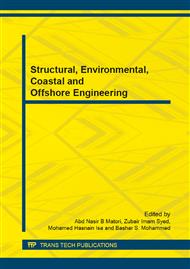[1]
C. Curtis, Planning for sustainable accessibility: The implementation challenge, Transport Policy, vol. 15, pp.104-112, (2008).
DOI: 10.1016/j.tranpol.2007.10.003
Google Scholar
[2]
R. Vickerman, Location, accessibility and regional development: the appraisal of trans-European networks, Transport Policy, vol. 2, pp.225-234, (1995).
DOI: 10.1016/s0967-070x(95)00013-g
Google Scholar
[3]
M. A. H. Talpur, M. Napiah, I. A. Chandio, and S. H. Khahro, Research Framework Focusing Transportation Accessibility Planning, Computer Based Modeling and Transportation Policy Outlines for Remote Regions of Developing World, Research Journal of Environmental and Earth Sciences, vol. 5, pp.32-40, (2013).
DOI: 10.19026/rjees.5.5636
Google Scholar
[4]
S. L. Handy and D. A. Niemeier, Measuring accessibility: an exploration of issues and alternatives, Environment and Planning A, vol. 29, pp.1175-1194, (1997).
DOI: 10.1068/a291175
Google Scholar
[5]
D. Halden, Using accessibility measures to integrate land use and transport policy in Edinburgh and the Lothians, Transport Policy, vol. 9, pp.313-324, (2002).
DOI: 10.1016/s0967-070x(02)00017-3
Google Scholar
[6]
S. Baradaran and F. Ramjerdi, Performance of accessibility measures in Europe, Journal of Transportation Statistics, vol. 4 (2/3), (2001).
Google Scholar
[7]
K. Geurs and V. E. Ritsema, Accessibility measures: review and applications. Evaluation of accessibility impacts of land-use transportation scenarios, and related social and economic impact, National Institute of Public Health and the Environment, (2001).
Google Scholar
[8]
K. T. Geurs and B. Van Wee, Accessibility evaluation of land-use and transport strategies: review and research directions, Journal of Transport Geography, vol. 12, pp.127-140, (2004).
DOI: 10.1016/j.jtrangeo.2003.10.005
Google Scholar
[9]
G. Vandenbulcke, T. Steenberghen, and I. Thomas, Mapping accessibility in Belgium: a tool for land-use and transport planning?, Journal of Transport Geography, vol. 17, pp.39-53, (2009).
DOI: 10.1016/j.jtrangeo.2008.04.008
Google Scholar
[10]
W. G. Hansen, How Accessibility Shapes Land Use, Journal of the American Institute of Planners, vol. 35, pp.73-76, (1959).
DOI: 10.1080/01944365908978307
Google Scholar
[11]
T. Hägerstrand, What about people in Regional Science?, Papers in Regional Science, vol. 24, pp.6-21, (1970).
DOI: 10.1007/bf01936872
Google Scholar
[12]
T. Neutens, F. Witlox, and P. Demaeyer, Individual accessibility and travel possibilities: A literature review on time geography, European Journal of Transport and Infrastructure Research (EJTIR), vol. 7 (4), pp.335-352, (2007).
Google Scholar
[13]
S. Winter and Z. -C. Yin, The elements of probabilistic time geography, GeoInformatica, vol. 15, pp.417-434, (2011).
DOI: 10.1007/s10707-010-0108-1
Google Scholar
[14]
D. Sui, Looking through Hägerstrand's dual vistas: towards a unifying framework for time geography, Journal of Transport Geography, vol. 23, pp.5-16, (2012).
DOI: 10.1016/j.jtrangeo.2012.03.020
Google Scholar
[15]
J. B. Odoki, H. R. Kerali, and F. Santorini, An integrated model for quantifying accessibility-benefits in developing countries, Transportation Research Part A: Policy and Practice, vol. 35, pp.601-623, (2001).
DOI: 10.1016/s0965-8564(00)00010-0
Google Scholar
[16]
Badin , Bureau of Statistics, Government of Pakistan, Islamabad, (1998).
Google Scholar
[17]
District Vision Badin (A Framework for Sustainable Development), ed: International Union for Conservation of Nature and Natural Resources. The World Conservation Union (IUCN), Pakistan, Sindh Programme Office, 1-Bath Island Road, Karachi-75530, 2006, p.134.
Google Scholar
[18]
D. Akerele, S. Momoh, S. A. Adewuyi, B. B. Phillip, and O. F. Ashaolu, Socioeconomic determinants of poverty among urban households in South-West Nigeria, International Journal of Social Economics, vol. 39 (3), pp.68-181, (2012).
DOI: 10.1108/03068291211199341
Google Scholar
[19]
A. Turner, I. Yansaneh, M. Jambwa, J. Banda, C. Menozzi, B. Kassa, and P. Benjamin, Designing Household Survey Samples: Practical Guidelines, United Nations, Newyork, (2008).
Google Scholar


